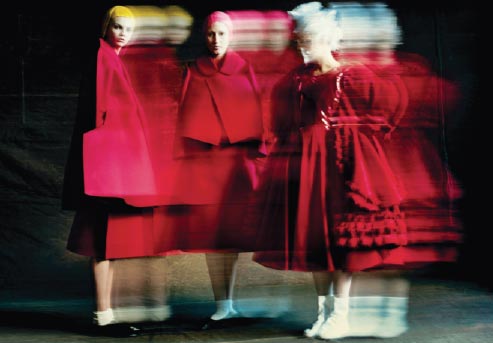Between worlds
By Sonia Altshuler ( China Daily ) Updated: 2017-07-01 08:47:04
 |
|
One of the first designers to truly challenge the notions of classic tailoring, Rei Kawakubo's cri de coeur has become deconstruction, bias cuts and all sorts of experiments in shape, seams and asymmetry. [Photo by Paolo Roversi/China Daily] |
Miuccia Prada is candid about Kawakubo's economically discreet impact on global fashion culture.
"I always say 'Thank God Rei doesn't want to be commercial'," Prada said in a 2016 interview with 10 Magazine. "Otherwise, we would all be dead."
It's precisely Kawakubo's market insensitive approach that defines her singularity. "If, as Andy Warhol proposed, 'Business art is the step after art,' Rei is its fashion manifestation," remarked Bolton. "It's within this elastic zone between fashion and commerce that Rei's 'art of the in-between' occupies and most powerfully expresses itself."
The closest Kawakubo ever came to outright commerciality was collaborating with Swedish retail giant H&M in 2008.
"I have always been interested, as an independent businesswoman, in the balance between creation, which is the core value of Comme des Garçons, and good business, which comes a close second," Kawakubo told this reporter that year. "Comme des Garçons with H&M is the epitome of this challenge."
Margareta van den Bosch, creative director at H&M (which is sponsoring the exhibition, along with Apple, Farfetch and Valentino) said that Kawakubo had been atop their wishlist for design collaborators from the start.
"She's always been at the forefront, experimenting with garments, never following any rules. We have tremendous respect for Kawakubo's fashion philosophy, which questions the entire fashion world's ingrained patterns."
One simple mantra may explain what has evolved: "It's easier to break the rules if you haven't learned them," Kawakubo told this reporter a decade ago. At the time of the collaboration with H&M, she was pre-empting millennial-speak: "There is more and more demand for independent points of view because not everyone wants to be the same as everyone else. Ultimately, people like to be free and independent, if given half the chance."
And in a world full of electronic excitation and daily digital onslaught, Kawakubo's retraction from culture is a plus. For someone so present in terms of influence, she's aesthetically and commercially absent. "Going around museums and galleries, seeing films, talking to people, seeing new shops, looking at silly magazines, taking an interest in the activities of people in the street, looking at art, traveling: all these things are not useful, all these things do not help me, do not give me any direct stimulation to help my search for something new. And neither does fashion history. The reason for that is that all these things above already exist," she said in the 2013 System interview. "I only can wait for the chance for something completely new to be born within myself."
Kawakubo makes for an inspiring figure and, for many, an epiphany.
"There is no right or wrong way," she said in an interview with this reporter. "Comme des Garçons is always looking for new ways to express its values, which are based around creating new ideas and making strong, creative clothes."
Visit the Met's Costume Institute and marvel at the below-theradar output of a woman whose work may be timeless, but whose moment of recognition-while more than welcome-is happening at least a decade too late.
|
|
|
|
|
|
|
|

























 Raymond Zhou:
Raymond Zhou: Pauline D Loh:
Pauline D Loh: Hot Pot
Hot Pot Eco China
Eco China China Dream
China Dream China Face
China Face






